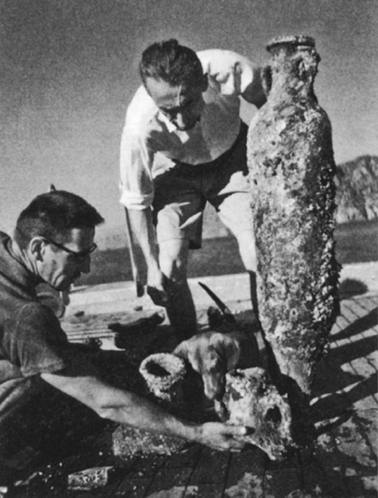
This Article From Issue
July-August 2010
Volume 98, Number 4
Page 354
DOI: 10.1511/2010.85.354
JACQUES COUSTEAU: The Sea King. Brad Matsen. xviii + 296 pp. Pantheon Books, 2009. $27.95.
An article by American journalist James Dugan that appeared in Science Illustrated in December of 1948 began as follows:
In the clear, warm waters of the French Riviera a new species of large mammalian fish have been observed in the last few years, one-eyed monsters shaped and colored like nude human beings with green rubber tail fins, gills of metal, and tubular scales on their backs. They are called Cousteau Divers. They swim around sportively at hundred-foot depths, examining sunken ships, taking photographs, and harpooning big fish. They are the first of the menfish, a new order of marine life invented by Lieutenant de Vaisseau Jacques-Yves Cousteau of the French Navy.

Jacques Cousteau died in 1997, but his remarkable ability to reveal worlds below the ocean’s surface continues to recruit many to be menfish and womenfish. I was one such recruit. Growing up in a landlocked Southern state, in my youth I rarely visited the ocean, but I devoured every page of the 21-volume encyclopedia The Ocean World of Jacques Cousteau. Those books and Cousteau’s television programs were staples of my childhood—my connection to the environment, to which I later dedicated my career. As a marine biologist, I continue to depend on technologies Cousteau developed decades ago to explore both the shallow and deep oceans. The key to his success in public outreach and education was fascination, and that model guides my own efforts to educate the public about oceans. Whenever anyone asks me what inspired me to become a marine biologist, I always begin my story with Jacques Cousteau.
Many people have a similar story to tell. In the superb new biography Jacques Cousteau: The Sea King, Brad Matsen notes that while he was researching the book, nearly every time he mentioned Cousteau’s name people would respond with testimonials about how they had been changed by him. “Everybody had a story,” Matsen says, adding that not all of the stories were kind to Cousteau’s memory.
Matsen handles the issue of how to separate the myths and legends from what was real about Cousteau’s life by showing him from a number of different perspectives, weaving the disparate stories told about Cousteau into a cohesive narrative with a dramatic structure like that of a great novel. The early chapters describe the innovations that Cousteau and his collaborators came up with that allowed for breathing, filming and living underwater. Next come accounts of the events that solidified his status as a legend: acquisition of the Calypso, the minesweeper that he converted into a research ship; the many expeditions that followed; filmmaking, and the Oscar won in 1956 by the documentary The Silent World; the launch of an enormously popular television series, The Undersea World of Jacques Cousteau; and the founding of the Cousteau Society, a nonprofit organization with “the protection and improvement of life” as its mission. Then a downward arc begins—the television series declines in popularity and is canceled. In 1979 Cousteau’s beloved son Philippe dies. The Cousteau Society deteriorates, exploration giving way to “military campaigns” to meet “a steady grind of production deadlines.” In 1990 Cousteau’s wife dies. A few weeks later he reveals to his son Jean-Michel that he intends to marry Francine Triplet, a woman he has been secretly seeing for 15 years, with whom he has two children. When Cousteau dies a few years later, having designated his new wife his successor, turmoil plagues the family and its enterprises. Matsen does not gloss over any of this, candidly titling the final chapter “Chaos.”
Small character portraits abound throughout the book, and Matsen ultimately portrays Cousteau as the sum of his interactions with the people around him. First we meet the woman who became his first wife, Simone Melchior, who later acquires the nickname “La Bergère” (the Shepherdess) when she plays the role of caretaker for the crew of the Calypso. Next we are introduced to Philippe Tailliez and Frédéric Dumas, who with Cousteau formed the Sea Musketeers; the three men worked together to perfect skills and technologies that made it possible to breathe underwater. A few chapters later Matsen shows Simone using her family connections to introduce Jacques to Émile Gagnan, who will help him develop the first self-contained underwater breathing apparatus (scuba), the Aqua-Lung. Other people important to the story include David Wolper, the creator of the television series The Undersea World of Jacques Cousteau, who developed the iconic look of Cousteau’s group (silver wet suits and yellow helmets ), and Ted Turner, who came to the financial rescue of the foundering Cousteau Society in the early 1980s.
Cousteau’s prized Calypso is also an integral character in this biography. In the preface, Matsen describes finding the ship several years ago with “weeping rust streaks from corroded fittings on its sooty white flank,” and he laments that “the wreck of the Calypso felt wrong, neglected, and dishonored.” The deterioration of this icon raises questions that he goes on to address in the book, which concludes with the information that the ship’s restoration is finally being undertaken. Over the course of the book we see that the Calypso was magnificent in her prime: Powered by two 800-horsepower diesel engines, she measured 136 feet long by 24.5 feet wide with a displacement of 270 tons. After starting out as a minesweeper, she had been converted into a ferry for passengers, cars and other cargo. Then Cousteau acquired her and transformed her from a mere seagoing vessel into the ship that ferried his vision around the world.
Cousteau once said to his son Jean-Michel that his life was “a lot of little things that came together just right.” The book confirms this: Matsen describes many instances in which events and people interconnected fortuitously to provide the tools and opportunities Cousteau needed. When Cousteau was a young man serving in the French Navy, he began swimming in the ocean to help facilitate his recovery from a car accident, and the officer he swam with turned out to be a snorkeling enthusiast who introduced him to the world beneath the water. (This same accident prevented Cousteau from becoming an aviator, which presumably saved his life, given that every member of his flight-school class was killed during the first few weeks of World War II.) During the war, Cousteau’s superior officers allowed him to continue experimenting with diving and underwater photography, recognizing that what he learned might have military applications. Decades later, the president of the Explorers Club in New York, Tom Moore, needed an after-dinner speaker on short notice and called on Cousteau; in return, Moore, who was also president of ABC, persuaded the network to give Cousteau a television series.
Matsen portrays Cousteau as neither angel nor demon but a complex man of contradictions. He was an environmentalist who preached stewardship of the world’s oceans and rivers, and he pleaded with the U.S. Congress to curb pollution on the coasts, but he let British Petroleum charter the Calypso for oil exploration and took money from Atlantic Richfield Petroleum Company (ARCO) for the PBS series Jacques Cousteau Odyssey. He described himself as an “honest witness” showing “the truth about nature,” but he orchestrated scenes for his television show. He publicly opposed removing animals from their natural habitat, but he ordered his crew to trap sea lions from the Cape of Good Hope and kept them in a cage aboard the Calypso. Cousteau was extremely adept at popularizing the ocean and life within it, yet he created an inefficient bureaucracy with an enormous budget at the Cousteau Society. By drawing these contrasts, Matsen captures the essence of Cousteau as a man whose accomplishments do not justify his faults and whose faults do not detract from his accomplishments.
Cousteau once said of his crew that they were “wounded by life on land, and . . . thereafter put trust in the sea”; those words perhaps apply equally well to Cousteau himself. He liked to contrast being bolted to the earth by the weight of gravity with the freedom that comes with being buoyed by water. “Underwater, man becomes an archangel,” he said. And that is how I think of him: in his element, as a manfish swimming below the surface of the ocean, free of the flaws that weighed him down on terra firma.
Craig McClain is assistant director of science at the National Evolutionary Synthesis Center in Durham, North Carolina.

American Scientist Comments and Discussion
To discuss our articles or comment on them, please share them and tag American Scientist on social media platforms. Here are links to our profiles on Twitter, Facebook, and LinkedIn.
If we re-share your post, we will moderate comments/discussion following our comments policy.